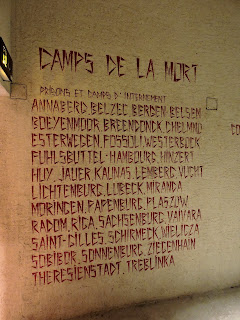I've waited months to use that clip. This class is so very heavy most of the time. We can always use a TARDIS.
Any way, the notes are a bit shy this week as well as link heavy.
Nazi Germany- The Underground Resistance
Among the Resistors was the brother/sister team of Hans and Sophie Scholl who made their anti-Nazi efforts at the University of Munich. This book about their lives was written by their sister, Inge Scholl. The link takes you to the book listing on Amazon. The White Rose, Munich 1942-1943
The White Rose is clip that sums up their efforts and the loss of their lives.
History File Nazi Germany: Opposition to Hitler. We viewed minutes 17:05 to 20:14.
For further reading, check out Germany's Underground: The Anti-Nazi Resistance by Allen Welsh Dulles.
While civilians were involved in various actions against the Nazis, the war dragged on and many in the Germany military were disillusioned of Hitler, and began planning Hitler's downfall.
The most well known assassination attempt was called the July Plot and was carried out by Claus von Stauffenberg. Real Valkyrie details the event. And you're welcome to those who remember Walter Cronkite. Operation Valkyrie was the contingency plan if anything were to happen to Hitler and the government thrown into an emergency. The hope was that after the death of Hitler, this plan would go into action, and the new leaders would end Nazi rule and the war.
There is a movie that stars Tom Cruise as von Stauffenberg called Valkyrie.
When speaking of the Resistance, we must also bring to light complicity. Studying Nazis and the Holocaust, if anything, begs some organization... a way to classify. Not that we should do this absolutely, but we are human. We know there were Nazis who were purely aligned with the Nazi ideology, Nazis in name, civilians who joined, civilians who abstained-- the bystanders. We know who the victims are, but how do we classify who was a perpetrator? Was it the ones who did the planning and the carrying out of the genocide? Was it those neighbors who turned in their Jewish neighbors? Can we lay blame on those who saw and yet did nothing? And what about the role of the clergy and the churches in Germany?
It's that last question we discussed in class. The role of the clergy and the church. This documentary is not my usual fodder, but put out by a group I've referenced many times over the last several months. It's Theologians Under Hitler which highlights the teachings of "Christian" Nazi enthusiasts... those who used their authority in the pulpit to justify the Holocaust and used their positions to back up Nazi policy and the Final Solution. This documentary specifically details Gerhard Kittel, Paul Althaus, and Emanuel Hirsch. We watched minutes 42:06 to 48:47 and 51:36 to 55:49.
On the flip side of the clergy that propagated Nazi ideology, we have Dietrich Bonhoeffer and Martin Niemöller. There is a fabulous biography by Eric Metaxas, Bonhoeffer: Pastor, Martyr, Prophet, Spy. Youtube is chalk full of interviews with Metaxas on Bonhoeffer. The clip here, Dietrich Bonhoeffer: Anti-Nazi Resistant and Resolute Hero, is Metaxas speaking.
Martin Niemöller was and is a controversial man. In his early days, he was pro Nazi and joined the party. As the party changed and became more antisemitic than Niemöller was comfortable with, he began speaking out against the Nazi party. Subsequently, he was arrested and interned at Dachau and Sachsenhausen from 1938 to 1945. He was in a separate section of the camps. He survived his incarceration and died in 1984, aged 92. Shortly after the war ended in 1945, he initiated the "Stuttgart Declaration of Guilt" that collectively apologized for the church's role in Nazism and the Holocaust. So soon after the war made this statement highly controversial as it read like the Treaty of Versailles with its "war guilt clause." Niemöller is most famous for this poem:
First they came for the Socialist, and I did not speak out--
Because I was not a Socialist.
Then they came for the trade unionists, and I did not speak out--
Because I was not a trade unionist.
Then they came for the Jews, and I did not speak out--
Because I was not a Jew.
Then they came for me--and there was no one left to speak for me.
This link is to an article titled "Church Complicity: Changing Views on German Churches and the Holocaust" found on the United States Holocaust Memorial Museum website.










